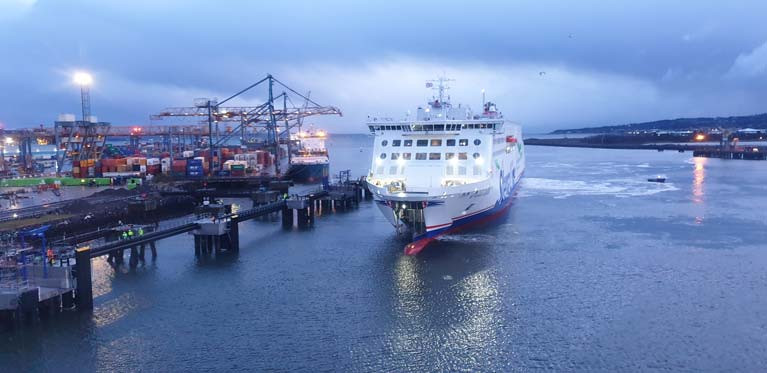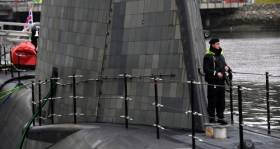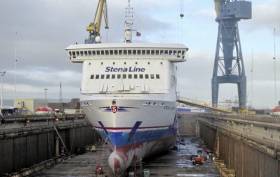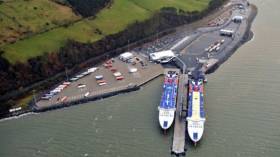Displaying items by tag: Stena
New Stena Line Ferry Arrives in Northern Ireland for Final Trials
The next generation of ferry travel proudly sailed into Belfast Harbour on Wednesday, with Stena Edda undertaking important final trials before it welcomes passengers on the Belfast Lough to Liverpool route in the coming weeks.
As Afloat reported earlier, the Stena Edda arrived at dawn after an epic four-week voyage and over six years’ in planning and construction, including design development in Sweden.
As part of this momentous occasion on its journey, the new advanced vessel took part in successful berthing trials at Belfast Harbour’s VT2 Terminal. A new access ramp has been specially built to accommodate the multi-million-pound ferry in Belfast.
With 40% more deck capacity, 40% more cabins and 30% more fuel-efficient than current vessels on the route, it will accommodate up to 1,000 passengers, 120 cars in its dedicated garage deck and 3,100 lane metres of freight.
It is more spacious inside with a Sky Bar and Scandinavian design providing new levels of comfort for both freight and travel guests. Despite the 215 metres length of the ferry, the new port infrastructure will deliver easier and faster loading and unloading for all passengers.
Stena Edda is part of a nine-figure investment by Stena Line in three new vessels and port upgrades, redefining ferry travel in the Irish Sea. Stena Edda is the first of two new ferries that will run on the popular Belfast to Liverpool route.
Increased Focus By Stena Line On Equality and Inclusion
#ferries - On International Women’s Day yesterday, Stena Line launched a new sustainability focus area – Equality and Inclusion. This is part of the company’s increased commitment to creating a sustainable working environment and an important step on the journey towards becoming a leader in sustainable shipping.
The ferry operator is committed to maintaining and developing a sustainable working environment, free from harassment, where everyone is given equal opportunities regardless of age, religion, gender, gender identity, sexual orientation, ethnicity or disability.
“At Stena Line we welcome everyone, whether you want to work here, travel with us or be one of our business partners. I am proud to announce that we are now increasing our focus on this important matter by adding another focus area to our sustainability strategy, says Ian Hampton, Chief People & Communications Officer at Stena Line.
A sustainability strategy is based on focus areas which are linked to the UN Global Goals for Sustainable Development and directly related to the company’s business. Equality and inclusion will be the fifth focus area, complementing the existing four areas - Clean energy, Good health and well-being, Life below water and Responsible consumption. For each area there are ambitious targets established and developments will be closely monitored, with the ambition of becoming a leader in Sustainable shipping.
“For equality and inclusion, the long-term goals are set to a minimum of 30% female leaders by 2022 and a zero-vision in terms of harassment. The work has already started with two new company policies for anti-harassment and equal opportunities launched last year”, said Margareta Jensen Dickson, Head of People at Stena Line.
In 2018 Stena Line also signed the Maritime UK’s “Women in Maritime Pledge” committing to “building an employment culture that actively supports and celebrates gender diversity, at all levels, throughout our organisation, and our industry”.
Main initiatives 2019
During 2019 the company will be focusing on anti-harassment initiatives, improving recruitment systems and procedures, promoting maritime careers for both men and women - as well as engaging in the “Women in Maritime Charter”.
“We need to deliver on a number of ambitious but achievable goals. For example, identifying obstacles in relation to recruitment and progression for women, improving recruitment methods for “decoded” job applications as well as benchmarking and mapping policies supporting a family friendly workplace and work-life balance for all, said Margareta Jensen Dickson, Head of People at Stena Line.
Care for customers
Diversity in the workforce not only contributes to a better working environment, it also helps Stena Line to better understand and care for its customers.
“Like us, our customers are diverse and the more knowledgeable we get, the better we will become at fulfilling their needs and creating a great travel experience which shows that we care”, says Ian Hampton, Chief People & Communications Officer at Stena Line.
Shipping Firms Reviewing UK-Registered Ships Ahead of Brexit
#ferries - Ferry giant, Stena based in Sweden and tanker firm Stolt-Nielsen which is Bermuda registered, are reviewing their UK-registered ships ahead of Britain’s departure from the EU, the two leading transport companies told Reuters separately on Wednesday (yesterday).
Such commercial decisions could complicate any attempts by the British government to secure extra space on ships to help cope with potential disruption to trade if it fails to secure a negotiated departure from the EU.
And any possible loss of ships will also be a blow to the UK’s ship registry, which forms part of the country’s maritime services industry. Shipping companies in many flag states pay corporation tax based on vessel tonnage rather than profit.
“In the light of the Brexit process we are considering whether the UK flag can become a possible issue for us when it no longer will be an EU flag post the 29th March 2019, but we have taken no decisions and are reviewing different scenarios,” said Ian Hampton, chief people & communications officer with Stena Line.
“Our fleet needs to be as flexible as possible.”
All commercial ships have to be registered, or flagged with a country, partly to comply with safety and environmental laws.
Stena Line is one of Europe’s largest ferry operators with a large part of the business concentrated around the UK.
For further reading about Stolt-Nielsen click here in addition British based operator P&O Ferries which announced last month it would shift the registration of its UK vessels to Cyprus ahead of Brexit.
Submarine in 'Near-Miss' with Stena Ferry In Irish Sea
#ferries - A Royal Navy nuclear-powered submarine has been involved in a near-miss with a ferry in the Irish Sea.
An investigation writes The Irish Times, has been launched into the previously unreported incident, which occurred on November 6th.
The ferry was Stena Superfast VII, which operates between Northern Ireland and Scotland.
It has a capacity for 1,300 passengers and 660 cars.
The submarine was submerged at the depth needed to extend its periscope above the surface of the water.
The Royal Navy would not confirm which of its 10 submarines was involved.
They are all nuclear-powered but only four carry Trident nuclear missiles.
A spokesman for the Marine Accident Investigation Branch (MAIB) said: “In November, we were notified of a close-quarters incident between the ro-ro [roll-on/roll-off] ferry Stena Superfast VII and a submarine operating at periscope depth.
To read more on the incident involving the ferry that operates Belfast-Cairnryan (not Stranraer as published) in the newspaper click here.
Operator Stena Turns to H&W for £5m Fleet Upgrade
#ferries - Work has begun on ferries from Stena Line which involves a £5 million refit programme of its local fleet at Belfast's Harland & Wolff shipyard.
The 10-week upgrade schedule reports the Irish News, will see five Stena vessels dry docked consecutively to facilitate refurbishment and maintenance works.
The move continues the carrier's long-standing relationship with H&W, and will represent a considerable boost to the supply chain.
For comments made from the ferry operator and the shipyard, click here.
Customers “Round Up for Charity” Mercy Ships On Board Stena Fleet
#ferry - During a month-long, fleet-wide donation campaign, Round Up for Charity, Stena Line and its customers raised an impressive €20,000 for the charity organisation Mercy Ships. The funds will enable Mercy Ship to help 133 people to get their sight back on board the hospital ship Africa Mercy.
The campaign which took place in November, involved customers across the Stena fleet of 38 vessels, who were encouraged to round up their onboard purchases and make a donation to Mercy Ships – a charity organisation sailing around the world bringing free, life-saving medical care to where it’s needed the most. There was also an impressive number of employee-initiatives to raise even more money for the charity. Some Stena Line employees rowed and cycling on board crossing the Irish Sea while others arranging quiz walks a shore and cake sales on board.
“An essential part of our partnership with Mercy Ships is to raise awareness about the organisation and this campaign has not only resulted in a generous monetary contribution from our customers, but also that more people are aware of Mercy Ships and their inspiring work. Many thanks to our employees for their engagement with the charity and their wonderful initiatives all across Europe”, says Niclas Mårtensson, CEO at Stena Line.
Stena Line’s customers donated €17,532, beating the result from last year’s donation campaign which ran for twice as long. With the additional contribution from the ferry operator, rounding up as well, the total amount of €20,000 will enable Mercy Ships help 133 people to get their sight back on board the hospital ship Africa Mercy.
“Because everyone on board Africa Mercy is there on a volunteer basis, we have managed to reduce the cost of an eye surgery to approximately €150. We are grateful so many of Stena Line’s customers chose to support our work and by doing so this has helped to change many lives. It has also been great to see the enthusiasm and engagement among the employees at Stena Line during the campaign,” said Tomas Fransson, National Director for Mercy Ships, Sweden.
The Round Up for Charity campaign was launched on all the ferries from 1 November. It ran for almost four weeks ending on Tuesday 27 November, a date which marked this year’s #GivingTuesday – a charity equivalent to Black Friday and Cyber Monday where instead of shopping people were encouraged to make a charity donation.
The humanitarian non-governmental organisation and Stena Line became partners in February 2017. The aim of the partnership is to raise awareness of Mercy Ships, increase the interest for donations among ferry customers and partners, as well as promote volunteering with their employees to share their unique technical and naval competence.
“In Mercy Ships, we have found a partner that is committed to helping those who need it the most, and like us see the benefits and the flexibility of having the ocean and ships as your workplace. This partnership is the most important part of our social sustainability initiatives, as it gives us an exciting opportunity to involve our employees, customers and partners in helping to make a difference. It also embodies our core value – care”, says Niclas Mårtensson, CEO at Stena Line.
Order Signed for Two Additional Stena E-Flexer Ferries
#FerryNews - An option to build a seventh and eighth of the E-Flexer ro ro class has been decided by Stena.
The two vessels will be deployed within the ferry company's route network with a planned delivery in 2022. Additionally, Stena RoRo has taken an option on the construction of a further four E-Flexer vessels also to be built at Avic Weihai Shipyard, China.
“We are very pleased to have ordered two additional E-Flexer vessels from Stena RoRo. We foresee increasing demand for freight capacity in Northern Europe and our new vessels fit very well in matching anticipated market developments as we prepare ourselves for further expansion. At this stage we haven’t decided where within our route network these two vessels will be deployed and are currently evaluating several options,”says Niclas Mårtensson, CEO Stena Line.
The new order and the four further options are important milestones for Stena RoRo.
“These vessels are the result of good cooperation between Stena RoRo and the AVIC Weihai Shipyard. With their strong design capabilities, Stena Line will be able to optimise its capacity to accommodate the vessels within most parts of its route network,” says Per Westling, MD Stena RoRo.
As with the previous E-Flexer vessels ordered by Stena, energy efficiency and sustainability will be key design features.
“We want to lead the development of sustainable shipping and set new industry standards when it comes to operational performance, emissions and cost competiveness,” says Niclas Mårtensson.
The two new ships on order will be larger than the three E-Flexer designs currently being built for Stena Line. The first three E-Flexer ships will be 215 meters long with 3 100 (lm) lane meters whilst the next two ships will measure 240 meters with a freight capacity of 3 600 lane meters.
“We are building on our successful RoPax concept mixing freight and passenger traffic. Through standardisation we can secure a reliable operation and by investing in tonnage that is flexible we can provide an even better product that will ultimately support our customers and help them to grow,” said Niclas Mårtensson.
A total of eight E-Flexers have now been ordered by Stena from Avic Weihai Shipyard in China. The first one is planned to operate on Holyhead-Dublin (in early 2020) and the next two delivered are planned to operate on the Liverpool-Belfast service. Three other vessels will be chartered out to external ferry operators by Stena RoRo.
Facts about E-Flexer 7 and 8
Length over all (LOA): 239,7 m
Width: 27,8 m
Draught, max: 6,4 m
Pax capacity: 1200
No of cabins: 263
Capacity: 3 600 lm
Estonian Operator Seals Deal to Sell Ro-Paxes to Stena
#ferry - A ferry operator from Estonia says sale boosts group's financial position, but not material to results.
Tallink Grupp said it concluded sales agreements with Sweden's Stena Line for the sale of two passenger-car ferries.
The group said the deals with Stena Ropax will cover the 32,728-gt Stena Superfast VII and Stena Superfast VIII. (Afloat adds the pair operate the Belfast-Cairnryan route)
Tallink said the deal is valued at EUR 133.5m ($152m). The vessels will be delivered to the buyer in December 2017. Until then, the vessels continue operations in the UK waters.
For more Tradewinds has a report here.
Newbuild Quartet for Stena Planned for Belfast Routes
#NewbuildsBelfast - A newbuild contract announced last year by Stena for a quartet of ropax ferry vessels with a delivery schedule during 2019 and 2020 are planned for Irish Sea service. The vessels are being built at the AVIC Shipyard in China. The plan is to locate the ferries specifically on routes to and from the line's expanding Belfast hub.
The contract also contains an option for another four vessels to be ordered.
“The routes to and from Belfast are strategically very important to Stena Line and during the last number of years we have made significant investments in ports and vessels to improve and develop our capacity offering a frequent high quality service for our customers to and from Belfast. Looking ahead, we intend to continue our ambitious development plan for our business in the region and the new vessels are a part of this strategic plan. During the last few years we have seen a steady growth in freight and passenger volumes and we believe this will continue. Last year was a record year for us when we for the first time carried over 500,000 freight units through Belfast Port. These new vessels will be the largest ferries ever to operate between Belfast and Great Britain”, said Stena Line’s CEO Niclas Mårtensson.
Joe O’Neill, Commercial Director, Belfast Harbour commented: “We are delighted that Stena Line is planning for Belfast as the location for its next generation of RoPax vessels in what is a significant investment in and enhancement of Northern Ireland’s premier freight and tourism gateway. Belfast Harbour has worked in close partnership with Stena Line over the last two decades to help it expand its Belfast routes into a flourishing hub and this very welcome investment news comes on the back of a record year for Stena Line’s freight business in Belfast Harbour. We look forward to welcoming the new vessels and the associated benefits they will bring to Belfast Harbour and the economy of Northern Ireland.”
The new vessels are being constructed in line with Stena Line’s strategic focus on sustainability.
“The new RoPax vessels will be among the most fuel efficient in the world with approximately 25% lower CO2 emissions per cargo unit than current RoPax tonnage. Our aim is to lead the development of sustainability within the shipping industry and set a new industry standard when it comes to operational performance, emissions and cost competiveness. The vessels will run on traditional fuel, but are designed to the class notation “gas ready” and are also prepared for scrubbers as well as catalytic converters, giving us flexibility for the future”, says Niclas Mårtensson.
Stena Line Ferry Company's Appeal Delayed
Leading ferry company Stena Line’s appeal hearing that was originally scheduled for July at the Lands Tribunal for Scotland has now been delayed until late November.
Stena Line has been involved in protracted discussions in relation to the rates assessment of its Loch Ryan Port and terminal facility at Cairnryan. As Afloat.ie reported in May, Stena Line made a significant capital investment, in excess of £80m, when it opened the new state-of-the art ferry port and terminal at Cairnryan in 2011 to replace its former Stranraer facility, an investment which has provided South West Scotland with the largest and most modern freight and tourism gateway in the area. Stena Line has appealed to the Lands Tribunal against the assessment of its non-domestic rates for the new port.
Paul Grant, Stena Line’s Route Manager said: “Stena Line is robustly challenging what is sees as an unfair rates assessment on what is a significant asset for the people and business of Scotland and welcomes the opportunity to put its case before the Lands Tribunal for Scotland in late November.”
Stena Line’s main concern with the current assessment is that it adds significant additional running costs for the company and may impact negatively upon future investment plans at Loch Ryan Port. Stena Line has received support from political representatives on this issue and has engaged Senior Counsel in an appeal against the assessment, which it maintains is without any proper legal basis, at the Lands Tribunal for Scotland.
































































